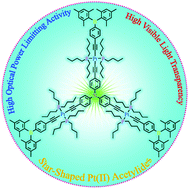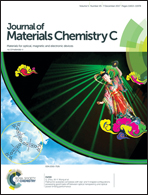Platinum(ii) acetylide complexes with star- and V-shaped configurations possessing good trade-off between optical transparency and optical power limiting performance†
Abstract
By employing the central ligand with the desired structures, two series of Pt(II) acetylide complexes containing dimesitylborane (–B(Mes)2) and phenyl units as the terminal groups with star- and V-shaped configurations have been synthesized. Photophysical investigations have indicated that the –B(Mes)2 group can enhance triplet (T1) emission of the concerned Pt(II) acetylide molecules by enhancing the mixing of molecular orbitals from organic ligands and Pt(II) centers. The much higher T1 emission intensity associated with TEB-Pt-B, CAZ-Pt-B and TPA-Pt-B can render them much stronger optical power limiting (OPL) response than their counterparts, TEB-Pt-Ph, CAZ-Pt-Ph and TPA-Pt-Ph respectively, terminated with phenyl groups. In addition, OPL ability of TPA-Pt-B for 532 nm nanosecond laser pulse can even surpass that of state-of-the-art OPL material C60. In addition, most Pt(II) acetylide complexes show OPL figure of merit factor σex/σo higher than that of C60. Importantly, the star-shaped molecular configuration employed by the Pt(II) acetylide units has the advantage of introducing more Pt(II) centers to the molecular skeleton while maintaining optical transparency of the concerned Pt(II) acetylide complexes. So, this research can open a new outlet for fulfilling the optimized trade-off between OPL activity and optical transparency for OPL materials based on reverse saturable absorption (RSA) mechanism.



 Please wait while we load your content...
Please wait while we load your content...